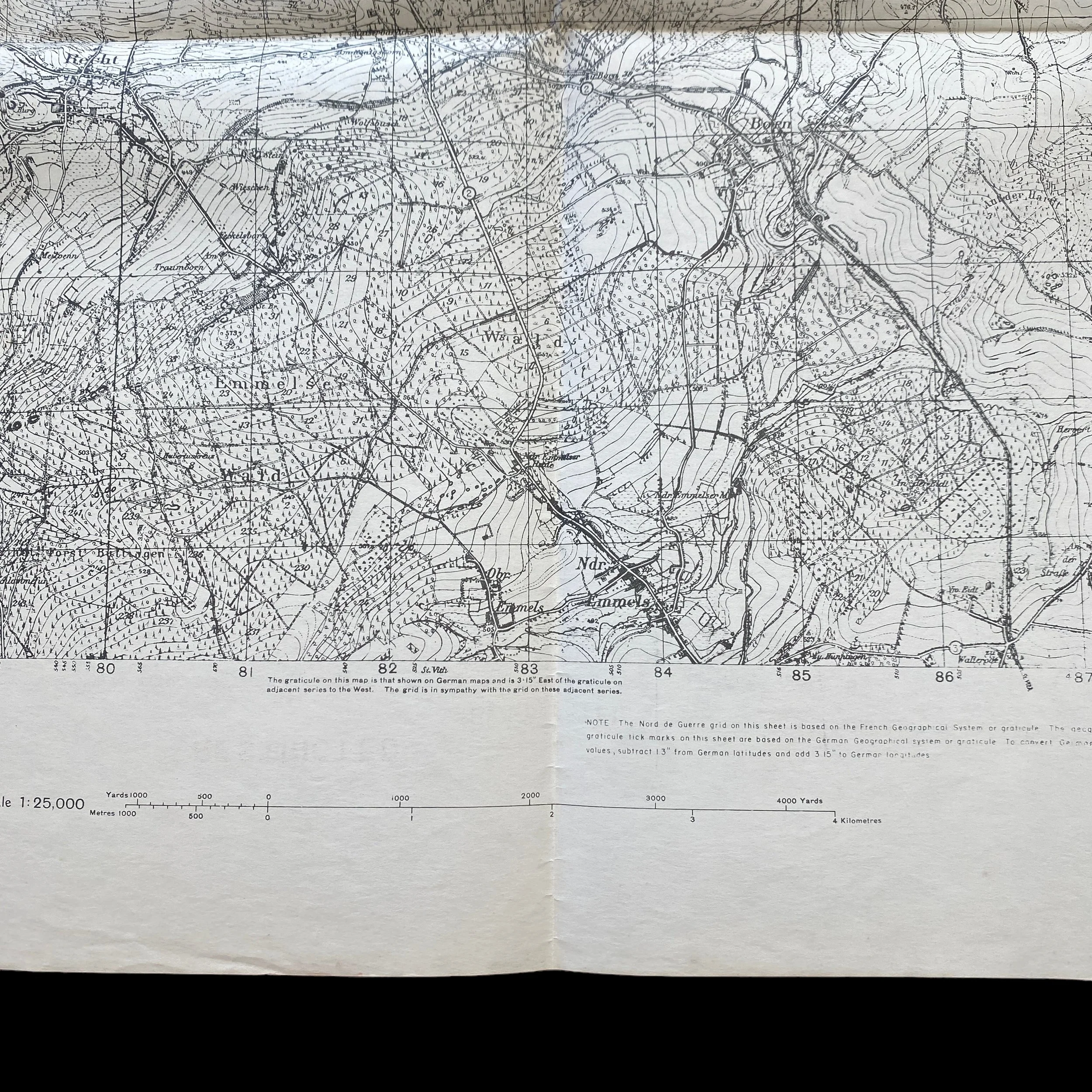VERY RARE! WWII Lt. Gen. George Patton’s Third Army "RESTRICTED" Siegfried Line (Blieskastel) Germany Combat Assault Map*




















































VERY RARE! WWII Lt. Gen. George Patton’s Third Army "RESTRICTED" Siegfried Line (Blieskastel) Germany Combat Assault Map*
Comes with C.O.A.
This incredibly rare and museum-grade Lorraine Campaign WWII 1944 Siegfried Line combat assault map was used by Lt. Gen. George Patton’s Third Army in 1944 as U.S. Infantry and Armored Divisions advanced from France into Germany. Also known as The Siegfried Line campaign was a phase in the Western European campaign of World War II which involved actions near the German defensive Siegfried Line. Titled “BLIESKASTEL” this combat assault is a very rare edition showing German bunkers, fortifications, machine guns emplacements, mortar positions, artillery, and for the first time the famous Siegfried Line antitank ditches known as the “dragon teeth”.
What makes this map even more rare is that it is printed on the backside of a previously used European Theater combat operations map. This was done to reuse resources on the front-lines when time and materials were limited.
This phase spans from the end of the Battle of Normandy, or Operation Overlord, (25 August 1944) incorporating the German winter counter-offensive through the Ardennes (commonly known as the Battle of the Bulge) and Operation Nordwind (in Alsace and Lorraine) up to the Allies preparing to cross the Rhine in the early months of 1945. This roughly corresponds with the official United States military European Theater of Operations Rhineland and Ardennes-Alsace campaigns.
This map shows the combat area just East of SAARBRUCKEN where the Germans made massive counterattacks on the American lines. The combat area shown on this combat assault map was where the US THIRD and US SEVENTH ARMY push on the FIRST GERMAN ARMY.
At this point, the German engineers had improved the Siegfried Line references to the point that it was the strongest section of the entire 390-mile fortified zone. Marked “RESTRICTED” this U.S. combat assault map was specially made to aid U.S. Infantry and Armored Divisions in assaulting the Siegfried Line. On the map, you can see clearly the line of German antitank barriers and reinforced concrete pillboxes and bunkers.
The Siegfried Line combat assault by Lt. Gen. George Patton’s Third Army in late 1944 on the Saar River and Merzig was a critical battle in the closing stages of World War II. The battle marked a significant turning point in the war, as it represented the first successful breach of the heavily fortified Siegfried Line, which had long served as Germany’s primary line of defence against an Allied invasion.
The Siegfried Line was a massive system of fortifications that stretched for hundreds of miles along the western border of Germany. The line consisted of concrete bunkers, anti-tank obstacles, and barbed wire entanglements, and was designed to slow down an invading army and provide time for the German army to mobilize and respond to an attack.
In late 1944, as the Allies continued their advance into Germany, Patton’s Third Army was tasked with breaching the Siegfried Line and pushing the German army back across the Saar River. The assault was a formidable challenge, as the Third Army was faced with a well-entrenched and determined enemy, as well as difficult terrain and harsh weather conditions.
Despite these challenges, Patton’s Third Army was able to achieve a decisive victory over the German forces in the Saar River and Merzig areas. The battle was fought with incredible ferocity and determination, with both sides showing remarkable bravery and resilience in the face of heavy casualties.
One of the key factors in the Third Army’s success was Patton’s aggressive and unorthodox tactics. Unlike many other military leaders of the time, Patton was known for his willingness to take risks and to think outside the box. He believed in the importance of speed and surprise, and he put these principles into action in the Siegfried Line assault.
One of the most notable examples of Patton’s unconventional tactics was his use of armored vehicles in the assault. He realized that the heavily fortified bunkers of the Siegfried Line would be nearly impervious to direct attacks by infantry, and he therefore ordered his tanks and armored vehicles to take the lead in the assault. This strategy allowed the Third Army to quickly break through the enemy’s defenses and establish a foothold on the other side of the Saar River.
Another critical factor in the Third Army’s success was the relentless determination of its soldiers. Despite the difficult conditions and heavy casualties, the soldiers of the Third Army fought on with incredible bravery and determination. They were motivated by a deep sense of duty and a desire to bring an end to the war and restore peace to Europe.
In the end, the Siegfried Line combat assault was a decisive victory for the Allies, and it marked a critical turning point in the war. The success of the Third Army in breaching the heavily fortified Siegfried Line paved the way for the final push into Germany and the eventual defeat of the Nazi regime.
The Siegfried Line combat assault was a testament to the bravery and determination of the soldiers who fought in the battle, as well as the strategic brilliance of their leader, General George Patton. It remains an important event in the history of World War II, and it serves as a reminder of the sacrifices made by those who fought and died to secure freedom and peace for future generations.